Almost 70 years before Nadia Comăneci and Nellie Kim scored their perfect 10s at the Montreal Olympics, there were several perfect scores awarded during the 1907 International Tournament. (The International Tournament was the original name for the World Championships.)
The majority of those perfect scores were for the French team. Nevertheless, the Czech Sokols, newcomers to the International Tournament, took first, ending the French team’s winning streak.
Oh, and, in 1907, one of the first age controversies in gymnastics occurred.
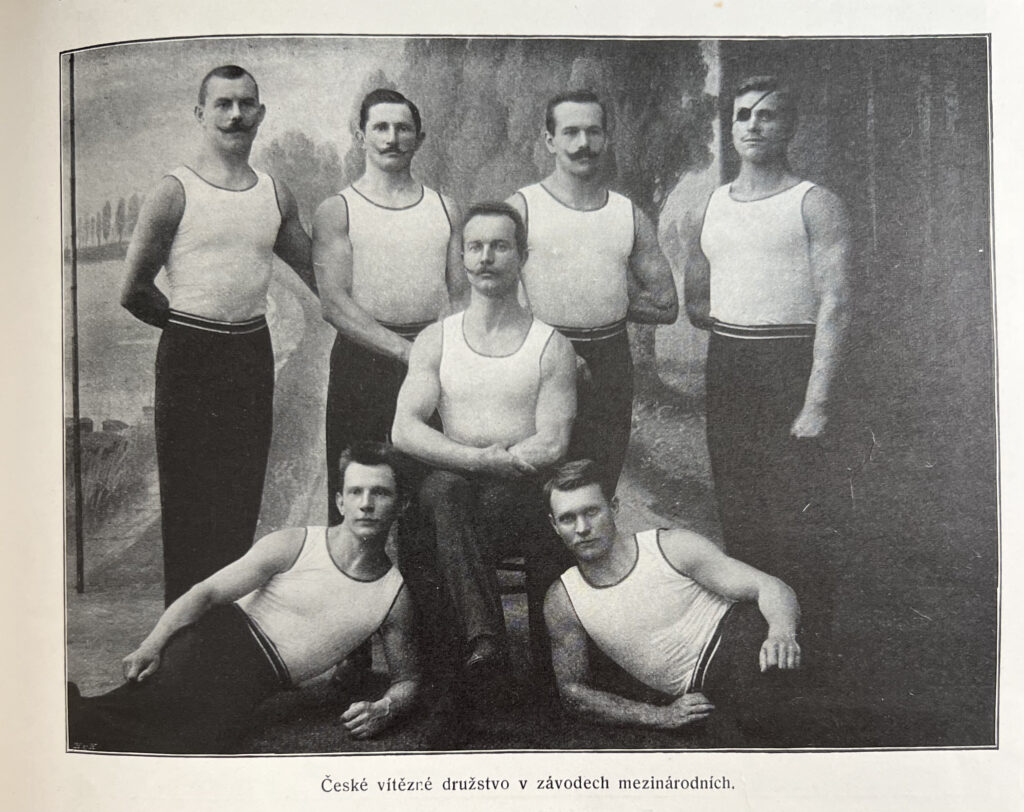
The Events | List of Gymnasts | List of Judges | Results | Perfect Scores | President Cupérus’s Thoughts | Age Controversy | | Czech Commentary on the Competition | Appendix A: Every Score from the Competition | Appendix B: Footage from the Slet
The Events
Held on June 30 in Prague, the International Tournament consisted of:
Ensemble:
- 5 sets of compulsory floor routines (without portable hand devices)*
Compulsory Routines:
- Long Horse Vault
- Parallel Bars
- Horizontal Bar
Optional Routines:
- Pommel Horse
- Parallel Bars
- Horizontal Bar
Track and field
- 150 m
- Combined high and long jump**
Other
- Lifting of a 35 kg weight, starting from a stance with legs spread and arm down, maximum of 20 times
*You can see the ensemble routines and listen to the accompaniment in this post.
**From the rules: Rope at a constant height of 1.10m. The jump is taken on a hard board located 2 m from the rope. The board is moved by 5 cm to a maximum of 3.60 m which gives 20 points. Two tries at each distance.
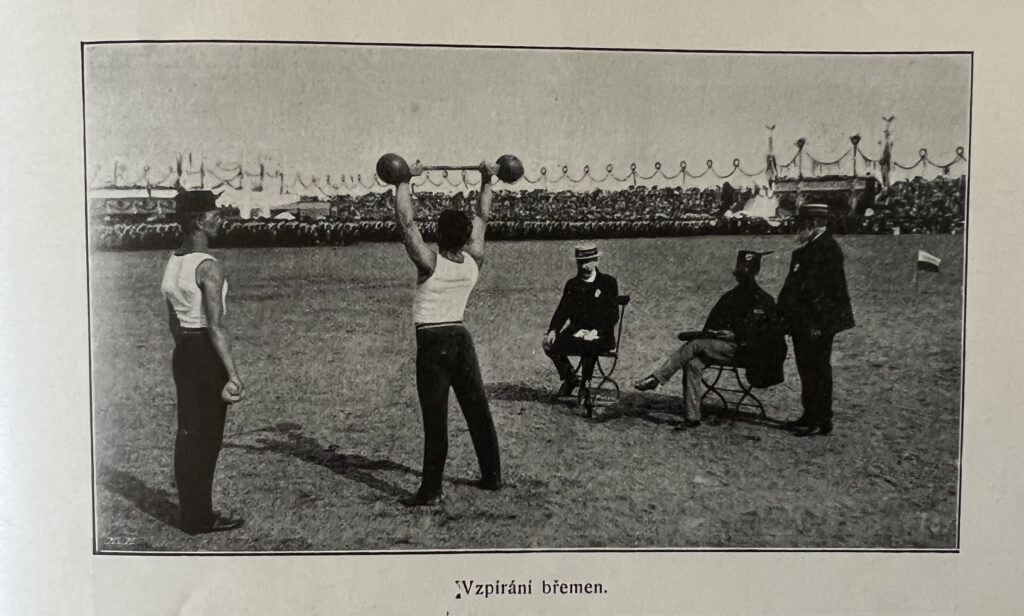
So, if you’re keeping track, here are the events of the first three World Championships:
| Event | 1903 | 1905 | 1907 |
| Ensemble FX Routines | 6 | 5 | 5 |
| Pommel Horse | 1 compulsory 1 optional | 1 compulsory 1 optional | 1 optional |
| Long Horse Vault | 1 compulsory | 1 compulsory | 1 compulsory |
| Parallel Bars | 2 compulsories 1 optional | 2 compulsories 1 optional | 1 compulsory 1 optional |
| High Bar | 2 compulsories 1 optional | 2 compulsories 1 optional | 1 compulsory 1 optional |
| Rings | 2 compulsories 1 optional | Not contested | Not contested |
| Race | 150 m | 150 m | 150 m |
| Jump | High Jump | Long Jump, alternating feet | Combined long + high jump |
| Other | Lifting a 40 kg weight | Throwing a 15-kg stone | Lifting a 35 kg weight |
The Gymnasts
Slovenia (Slovenska Sokolska Sveza)
- Dr. Viktor Murnik
- Fran Milavk
- Vladimir Deklevec
- Albin Kandare
- Anton Thaler
- Josip Rihar
- Leader: Dr. Janko Savnik
Belgium (Fédération belge de Gymnastique, Belgische Turnbond)
- Pol. Giesenfeld, Malines
- Herm. Carsau, Boom
- Karel Lannie, Boom
- Louis de Winter, Boom
- Leo Pauwels, St. Nikolaas-Waas
- Paul Mangin, Antwerp
- Leader: Oscar Delaive, Antwerp
Hungary (Magyarországi Testedző Egyesületek Szövetsége)
- J. Kmetykó
- Lakatos Lichtmann
- L. Kmetykó
- Ferd. Kováts
- Alex. Bak
- K. Bajor
- Leader: R. Bábel
Czech (Česká obec Sokolská)
- K. Starý, Poděbrady
- Josef Seidl, Prague
- František Erben, Plzeň
- Bohuš Honzátko, Prague
- Josef Čada, Prague
- K. Sál, Prague
- Leader: Fr. Prečner
Note: Čada is sometimes spelled as Czada.
Luxembourg (Union des Sociétés Luxembourgeoises de Gymnastique)
- Guillaume Hary, Luxembourg
- Charles Behm, Luxembourg
- Nicolas Kanivé, Luxembourg
- André Bordang, Pulvermuhl
- Ernest Greiveldinger, Remich
- Nicolas Kummer, Eich
- Leader: Aloys Kayser, Roodt
France (Union des Sociétés de Gymnastique de France)
- Charmoille, Nancy
- Joseph Castigliani, Sidi-Bel-Abbès
- François Vidal, Sidi-Bel-Abbès
- Jules Rolland, Hautmont
- Joseph Lux, Thaon
- Louis Segura, Sidi-Bel-Abbès
- Leader: H. Audemars, Arras
The Judges
Belgium
- Jos. De Wallens, Brussels
- Frans Peeters, Antwerp
Czech
- Vlad. Müller, Prague
- J. Dufek, Žižkov
France
- P. Christmann, Paris
- Dalmas, Hautmont
Luxembourg
- Pierre Feyder, Luxembourg
- Jules Graff, Trois-Vierges
Hungary
- K. Iszer, Budapest
- K. Demény, Budapest
Slovenian
- Julij Novak, Idrija
- Eugen Sajovic, Kranj
Source: Cupérus’s report, printed and translated in: Sokol, 1907, 7-8
Note: The Czechs noted that Hungary’s Demény was not in attendance:
For the Hungarians: Messrs. Charles Iszers from Budapest, the other did not show up.
Za Maďary: Pánové Charles z Iszerů z Budapešti, druhý se nedostavil.
V. slet všesokolský 1907: pamětní list vydaný péči
The Team Results
Note: You can scroll to the right in the tables below.
| Prelim. Exercises | Parallel Bars | High Bar | Horse | Jump | Weights | 150 m | Total | |
| Czech | 275.00 | 119.50 | 131.00 | 120.75 | 92 | 113 | 100 | 951.25 |
| France | 284.50 | 119.50 | 141.50 | 119.50 | 76 | 88 | 94 | 923.00 |
| Belgium | 274.75 | 94.75 | 125.00 | 117.75 | 68 | 100 | 92 | 872.25 |
| Luxembourg | 239.00 | 84.25 | 106.25 | 80.25 | 70 | 111 | 98 | 788.75 |
| Slovenian | 256.00 | 78.25 | 97.25 | 105.75 | 56 | 100 | 78 | 771.25 |
| Hungary | 237.50 | 68.25 | 76.00 | 81.50 | 84 | 90 | 96 | 733.25 |
Reminder: Scores were not announced during the competition, so the teams had no clue how they fared until the very end. More on the rules here.
Further Breakdown
The official book from the 1907 Sokol slet (V. slet všesokolský 1907: pamětní list vydaný péči) printed full results for each team. You can find them in Appendix A.
If you’re keeping track of the places…
| 1903 | 1905 | 1907 | |
| 1st | France | France | Czech Sokols |
| 2nd | Belgium | Netherlands | France |
| 3rd | Luxembourg | Belgium | Belgium |
| 4th | Netherlands | Luxembourg | Luxembourg |
| 5th | Slovenian Sokols | ||
| 6th | Hungary |
What did the teams win?
1st place: Czech Sokols: a precious Sèvres vase, a gift from the French Republic
2nd place: France: a bronze cast of Schnirch’s St. Wenceslas, a gift from the Czech gymnasts
3rd place: Belgium: a glass wine cutlery, bearing the emblems of Žižek and the lords beheaded in the Old Town Square (product of the Harrachov glassworks), gift from the Czech Sokol Community
4th place: Luxembourg: a silver cup with engravings, donated by Mr. Cupérus
5th place: Slovenians: Album of Luxembourg
6th place: Hungary: a glass beer cutlery, a gift of the Czech Sokol Community
Source: V. slet všesokolský 1907: pamětní list vydaný péči
Yes, one of the prizes was related to a series of beheadings in 1621. If you want to learn more about the historical event, look up the Old Town Square Execution (Staroměstská exekuce in Czech).
The Perfect Scores
There were several perfect scores in Prague. During the preliminary exercises, the following gymnasts received perfect 10s:
- Seidl, Czech Sokols
- Fifth exercise.
- Čada, Czech Sokols
- First exercise
- Fifth exercise
- Lux, France
- Second exercise
- Fifth exercise
- Ségura, France
- First exercise
- Fifth exercise
- Giesenfeld, Belgium
- Second
- Fourth
- Fifth
- Pauwels, Belgium
- Fourth exercise.
You can see the preliminary exercises here.
In addition, there were perfect 10s on the apparatus:
- Erben, Czech, Parallel Bars, Optionals
- Erben, Czech, High Bar, Optionals
- Charmoille, France, High Bar, Optionals
- Vidal, France, High Bar, Compulsories
- Vidal, France, High Bar, Optionals
- Rolland, France, High Bar, Optionals
- Lux, France, High Bar, Optionals
- Ségura, France, High Bar, Optionals
Really, they were perfect 12s because, in addition to the 10 points for the routine, the aforementioned gymnasts received 1 full point for their mounts and 1 full point for their dismounts.
Vidal of France got a perfect total of 24.00 on high bar.
This wasn’t the first perfect total in the history of the International Tournament. Lalu had a perfect total (36.00) on high bar in 1905.
Note #1: While this was a team-only competition, the FIG has chosen to retroactively recognize event winners. In 125 Years of the FIG: The Story Goes on, the FIG lists Erben and Charmoille as the high bar champions. That is a mistake, given that Vidal had a perfect 24 on high bar.
Note #2: There were also perfect 20s in the track and field events.
The President’s Thoughts
Cupérus was the president of the Bureau of European Gymnastics Federations, which later was renamed the FIG. He wrote a report on the International Tournament, which the Czech publication Sokol translated in issue 7-8. Here are a few of his thoughts.
There were many interruptions, including a parade.
Around 11 a.m., the cars took the judges and competitors to the parade, which prompted the people of Prague to show enthusiasm as a token of the great favor shown by both the nation and the local authorities to the Sokol club and its mission. Unfortunately, however, the mishap interrupted the quiet continuation of the competition: the jury members returned late, being stuck in other jobs, and the competition, therefore, began much later. It was the time for public practice and it was necessary for some who were working at the training ground to leave and [the public] practice occupied the entire training ground, so the competition continued much later.
Kolem 11. hod. vozy připravené odvezly soudce a závodníky k průvodu, což dalo podnět obyvatelstvu Prahy k projevům nadšení, na důkaz veliké přizně, kterou chová jak národ tak i úřady samosprávné vůči Sokolstvu a jeho úkolu. Odchylka ta však bohužel přerušila klidné pokračování v závodech: členové sboru soudcovského pozdě se vrátili, jsouce zadrženi jinými funkcemi a závody tedy počaly mnohem později. To bylo příčinou, že nadešla hodina veřejného cvičení a bylo nutno, aby někteři, jsouce zaměstnáni na cvičišti, se vzdálili a celé cvičiště bylo zabráno cvičením, takže v závodech proto mnohem později pokračováno.
The 150 m race was a mess.
In the running competition, there were many mistakes.
The track, which was too cramped, was partially blocked at one point and it was necessary to repeat one of the races.
V závodu v běhu sběhly se chyby.
Dráha příliš stísněně upravená byla v jedné chvíli z části zabrana a bylo nutno závod některý opakovati.
The International Tournament was happening at the same time as the Sokol Rally, and there wasn’t enough designated area for the Tournament.
Next time, it is necessary that the landscaping and the use of the terrain for the competition be determined very strictly. The designated place must be very strictly kept, time for the competition itself must not be dedicated only according to the needs of other festive programs […].
Jest zapotřebí, aby příště velmi přesně byla stanovena úprava i použití terénu k závodům. Místo k tomu určené musí velmi přísně býti udrženo, čas k závodům nesmí býti vyměřován dle potřeby ostatního pořadu slavnostního […].
There were complaints because one of the French gymnasts was not old enough.
It will be more than sufficient for the next time for the unions to present 6 gymnasts on the day of the competition with the team, who will present a certificate of their civic identity and the requirements for the membership of the gym club required at the moment. This would be much shorter even in the case of complaints, the subject of which, for example, was one too young member of a French team in Prague.
Postačí, když přiště svazy předstoupí v den závodu s družstvem závodním 6 gymnastů, kteří předloží průkaz o identitě své občanské a o náležitostech, jaké členství tělocv, jednoť vyžaduje. To by bylo mnohem kratší i pro případ reklamací, jichž na př. předmětem byl v Praze jeden příliš mladý člen družstva francouzského.
In 1909, the Luxembourg press would state:
The other model gymnasts also worked, and it is a pleasure to watch. In no case should we forget about the young Algerian Segnora, who deserves a special award. Barely 16 years old, they wanted to disqualify him 2 years ago in Prague, because he wasn’t the regulatory age.
Luxemburger Wort, August 1, 1909
Auf keinen Fall dürfen wir des jungen Algeriers Segnora vergessen, der eigentlich eine besondere Auszeichnung verdient. Kaum 16 Jahre alt, wollte man ihn vor 2 Jahren in Prag disqualifizieren, weil er das reglementsmäßige Alter nicht haben sollte.
Note: The Luxemburger Wort most likely meant Ségura, who would have been 17 on June 30, 1907. The regulations required gymnasts to be 18. Nevertheless, Ségura was allowed to compete.
The judges needed to be there to judge and not have other obligations.
At the same time, we would like the members of the jury not to be swept away with the other tasks that would prevent them from performing their judicial functions, as happened in Prague, where Mr. Christmann was late, as he was acting as a member of the jury and as a member of the French delegation at City Hall and Mr. Müller, a Czech jury member. They had to put their duties in the administrative body on hold, as they should be part of practice within calisthenics. Fortunately, these cases did not significantly impact the continuation of regular competition, but it is still necessary to point them out to avoid this situation in the future.
Zároveň bychom si přáli, aby členové soudcovského sboru nebyli stižení jinými úkoly, jež by jim překážely ve vykonávání funkcí soudcovských, jak se to stalo v Praze, kde pan Christmann byl zdržen jako člen jury a jako člen francouzské delegace na radnici odevzdáním čestného daru, a pan Müller, soudce český, který musil přerušiti svůj úřad, jsa povolán jako vedoucí při společných cvičeních prostných. Tyto případy na štěstí neměly velikého vlivu na pokračování v pravidelných pracích závodních, avšak přece jen jest zapotřebí podotknouti je k uvarování v budoucnosti.
One French gymnast was injured.
The accident, which happened to one member of the French competition team, was the cause of the interruption, which we determined to be up to 20 minutes, but also without interference.
Úraz, který se přihodil jednomu členu francouzského družstva závodního, byl příčinou přerušení, které jsme stanovili až do 20 minut, avšak rovněž bez vlivu rušícího.
It was a pain to organize the competition by mail correspondence.
It is also necessary that the technical staff members be appointed only by those who can answer questions by post immediately. This time, many members of the technical department had to wait many weeks, which significantly delayed the program preparation.
Jest dále zapotřebí, aby členy technického sboru byly jmenovány jen takové osoby, které mohou odpovídati na dotazy obratem pošty. Tentokrát mnozí členové z technického odboru dali na sebe čekati dlouhé týdny, čímž bylo velmi zdrženo vypracování programu.
Notes on the Belgian Team from Cupérus
In July, Cupérus, the President of the Belgian Gymnastics Federation and the Bureau of the European Gymnastics Associations, wrote a letter to the editor of Le Matin. Here are a few observations worth highlighting.
The Belgian Federation is small, so their third-place finish was incredible.
The successes achieved are remarkable, the little “Belgian Federation” having won not only all hearts, but also 3rd place – and almost the first if there were not two small hitches.
Le Matin, July 23, 1907; all quotations in this section are from this issue.
Les succès remportés sont remarquables, la petite “Fédération belge” ayant conquis non seulement tous les coeurs, mais encor la 3me place — et presque la première s’il n’y avait en deux petits accrocs.
The gymnasts weren’t a national team, but rather, just the six gymnasts who volunteered to go.
All this is very comforting for us when we consider that these 6 gymnasts did not form a sorted section, strictly speaking, but were the only ones who had presented themselves to make the trip, the Federation not having special funds for such objects.
Tout cela est fort réconfortant pour nous quand on songe que ces 6 gymnastes ne formaient pas à proprement parler une section triée, mais étaient les seuls qui se fussent présentés pour faire le voyage, la Fédération ne disposant pas de fonds spéciaux pour de pareils objets.
Their ensemble exercises were a thing of beauty.
The report of the special reviews is enthusiastic and all in favor of the Belgian gymnasts.
The reporter of the “Deutsche Turnzeitung,” in particular, Dr. R. Gasch, from Leipzig, says:
“Never in my life have I seen free exercises executed in such an impeccable manner as by these 6 Belgian gymnasts.”
For their apparatus exercises, in particular those on horizontal bar, the same reporter has no less glowing terms.
Le compte rendu des revues spéciales est enthousiaste et tout en faveur aux gymnastes belges.
Le reporter de la “Deutsche Turnzeitung,” notamment, le Dr. R. Gasch, de Leipzig, dit:
“Jamais de ma vie je n’ai vu exécuter des exercices libres d’une manière aussi impeccable que par ces 6 gymnastes belges.”
Pour leurs exercices aux engins, en particulier ceux au rec, le même reporter a des termes non moins élogieux.
The Czech Commentary
The official book for the Sokol slet (V. slet všesokolský 1907: pamětní list vydaný péči) included a lengthy report on the International Tournament. Here’s a summary.
General Comments
There weren’t any major injuries.
There was no accident during the competition. Two minor injuries did not affect the course of the competition and the competitors were able to continue. Thus one of the Slovenes tore a callus between his fingers on the high bar, and one of the French flew off the high bar. The bruised rib he suffered in the process improved after a 20-minute rest, and he finished the competition.
Nehoda se nestala při závodu žádná. Dva menší úrazy neměly vlivu na průběh závodů, závodníci mohli pokračovati. Tak jeden ze Slovinců roztrhl si na hrazdě mezi prsty mozol a jeden z Francouzů ulétl z hrazdy. Zhmoždění žebra, jež při tom utrpěl, po 20 minutovém odpočinku se zlepšilo, že závod dokončil.
The Czech public was hospitable towards all the teams.
The audience treated all the teams, regardless of nationality, fairly, rewarding every good performance with praise. This characteristic of our crowd was picked up by all the foreign teams and consequently, they fought for its favor with jealousy? The French and Belgians were most jealous of each other, and at first, found it hard to bear the French being honored so much. But the next day (Sunday) they were reconciled, became better known, and received much praise.
Obecenstvo chovalo se ke všem družstvům bez rozdílu národnosti spravedlivě, odměňujíc každý dobrý výkon pochvalou. Tuto vlastnost našeho obecenstva vystihla všecka cizí družstva a následkem toho zápasila o jeho přízeň se žárlivosti? někdy až úsměv budicí, Nejvíce najsebe žárlili Francouzi s Belgičany, kteří z počátku těžce nesli, že Francouzi jsou tolik vyznamenáváni. Druhý den však (v neděli) už byli usmíření, stali se známějšími a sklízeli i oni mnoho pochvalv.
Note: This point will reappear during future World Championships when the Czech team travels elsewhere and receives little applause.
The teams were each unique, showing off their national styles.
The competition contained a wealth of impressions and insights in every direction. – Already the appearance of the teams was so different: each nation bore its national and gymnastic individuality.
Závod skytal celé bohatství dojmů a poznatků v každém směru. — Již vzhled družstev byl tak různý: každý národ nesl tu svojí individualitu národní a tělocvičnou.
On the Belgians
The Belgians were quite flashy, both in attire and their routines. However, their preliminary calisthenics exercises were not as precise as they needed to be.
So the Belgians were beautiful, slim people, with magnificent chests. They were dressed in a beautiful dark blue tight-fitting outfit with a lion embroidered on the chest. This costume was very reminiscent of the Italians, especially the black and yellow sash on the outside of the trousers. They dressed up for the competitions as if they were in ferment. They excelled especially on the high bar. Their magnificent giant swings and throws had a special serpentine elegance, enhanced by the adjacent attire. When they performed all their optional routines for the first time on Saturday, we knew that they would be very dangerous opponents, yes, perhaps even winners. They were weaker on horse. In the preliminary calisthenics, the desire for effect stood out even more, sometimes veering into frills and theatrics. The interplay in the preliminary calisthenics was perfect, but the working out in the individual parts was not as thorough as that of the French and the Czechs, and yes, even the Luxembourgians. Thus, in the lunges, they bent their knees little, the backward and outward reverses in the fourth section were without power, mere sways. They executed the 3rd section nicely. The first section practiced with deviation in the curves. This deviation was made by the Luxembourg and Hungarian teams, except for the French, but they did not consider it a mistake, because the text said so. The Belgians lost a lot of points in the jumping and weights events. They suffered greatly from the heat, and their pale faces showed that they were not accustomed to practicing in the sun.
Tak Belgičané byli krásní štíhlí lidé, skvostných hrudníků. Oděni byli v nádherný tmavomodrý přilehavý úbor s vyšitým Ivem na prsou. Krojtento připomínal velmi na Italy, zejména ona čornožlutá paspule na vnější straně nohavic. Vystrojili se na závody jako ku kvasu. Vynikali hlavně na hrazdě. Skvostné jejich veletoče a mety měly zvláštní hadovitou eleganci, zvyšovanou ještě přilehavým úborem. Když poprvé v sobotu předváděli veškeré své volné cviky, poznali jsme, že budou velmi nebezpečnými soupeři, ano že snad i vítězi. Slabšími byli na koni. V prostných vynikala snaha po efektu ještě více, která zabíhala někdy až do kudrlinek a divadelnictví. Souhra v prostných byla dokonalá, ale vypracování v jednotlivostech nebylo tak důkladné jako u Francouzů a Čechů, ano i Luxemburčanů. Tak při výpadech málo ohýbali kolena, rub nazad a rub vnější ve IV. oddílu byly bez síly, pouhé kmihy. Pěkně provedli III. oddíl. První oddíl cvičili s odchylkou v obloucích. Tuto odchylku až na Francouze činila ještě družstva luxemburské a maďarské, nečítalo se jim to však za chybu, ježto text prý tak zněl. Belgičané ztratili hodně bodů na skocích a břemenech. Velice trpěli horkem a pobledlé jejich tváře svědčily, že nebyli zvyklí cvičiti na slunci.
Note: If you enjoy gender studies, the depictions of masculinity in these passages will be of interest to you.
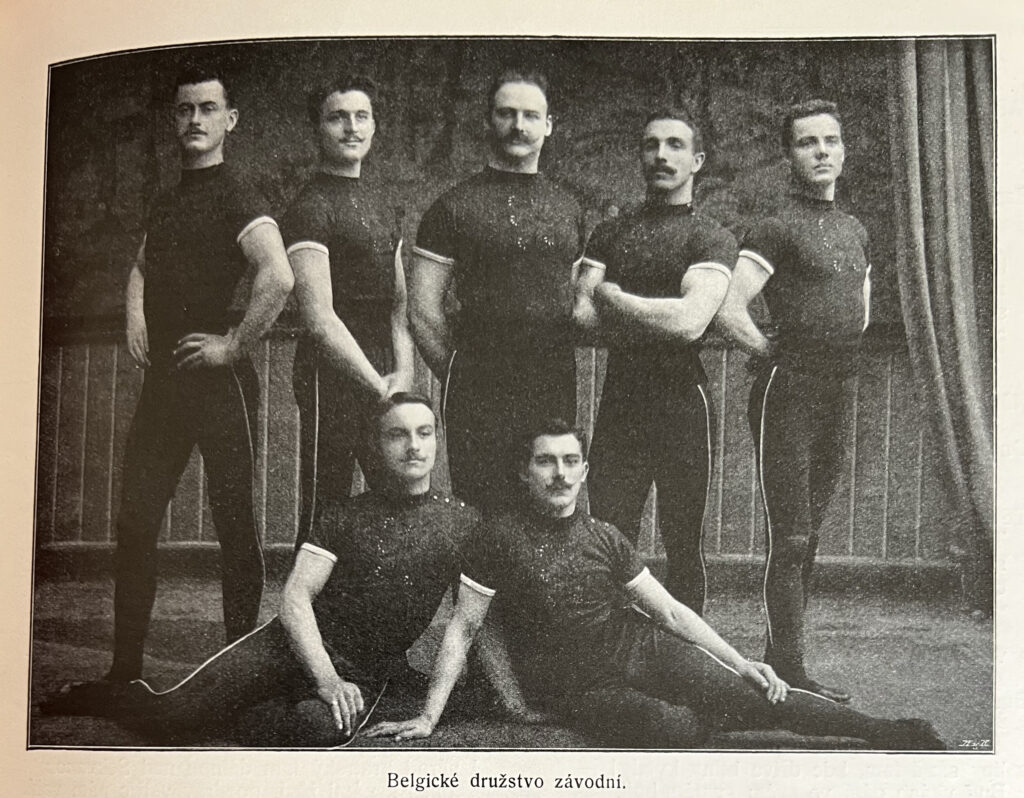
On the French team
The French were fantastic. Their performance made the heart dance.
The French team made a less conspicuous but real impression. It was not so symmetrical, the last three were of smaller stature, but they were also quite attractive people, the first three beautiful. Their exercises had something irresistible and rapid about them. They performed our calisthenics in a way that made the heart dance. Passionate in their individuality, ideal in their interplay, and a fine entrance to boot. They had the most points on the preliminary calisthenics of any team. In these, the champions are still unsurpassed. Section IV (hornpipe) was performed magnificently.
Francouzské družstvo činilo dojem méně nápadný, ale za to opravdový. Nebylo tak souměrné, poslední tři byli menších postav, ale i oni byli celkem hezcí lidé, první tři krásní. Cvičení jejich mělo v sobě cosí nezdolného a prudkého. Naše sletová prostná provedli tak, že srdce plesalo. Vášnivě v jednotlivostech, ideálně v souhře a k tomu pěkný nástup. Měli nejvíce bodů na prostná ze všech družstev V těch jsou mistři dosud nepřekonaní. Oddíl IV. (rohovnický) byl proveden úchvatně.
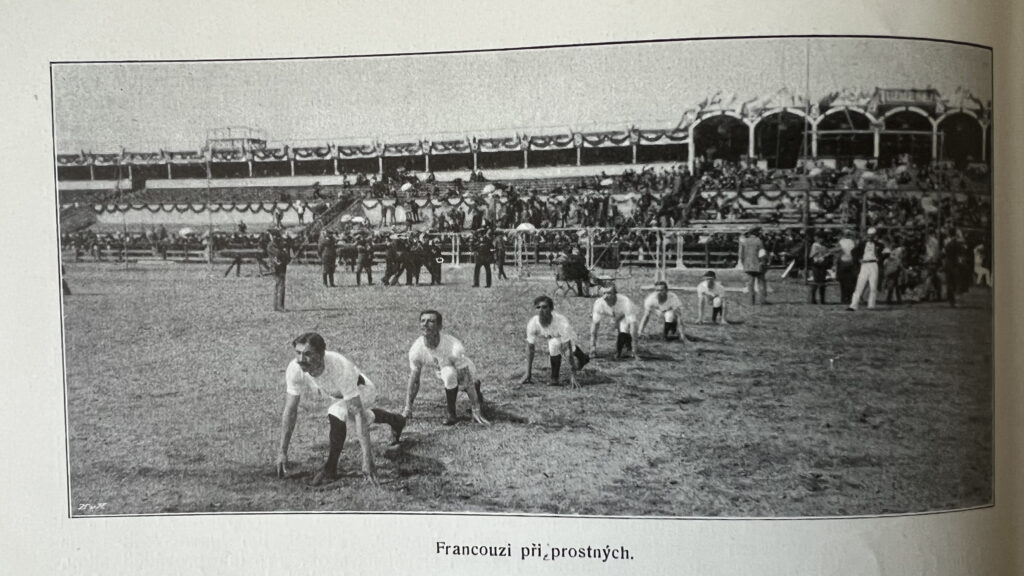
On the Luxembourgian Team
The Luxembourg team was athletic, but they lacked dynamism.
Luxembourg’s team gave a rather athletic impression. They wore dark brown outfits, tight, stockings black, bare arms, flat caps. They were modest, good fellows, real workmen, a little slow; their training was good. They performed the calisthenics well, both as a team and individually, but in a sort of drawn-out and fireless way. Among the brilliance of the Belgian and French squads, they were a bit lost.
Luxemburské družstvo činilo dojem spíše athletický. Měli tmavohnědý úbor, přilehavý, punčochy černé, nahé paže, placaté čepice. Byli to skromní, dobří hoši, praví dříči, trochu pomalí; výcvik měli dobrý. Prostná prováděli v souhře i v jednotlivostech dobře, avšak jaksi tažně a bez ohně. V lesku družstva belgického a francouzského se trochu ztcompetitionli.
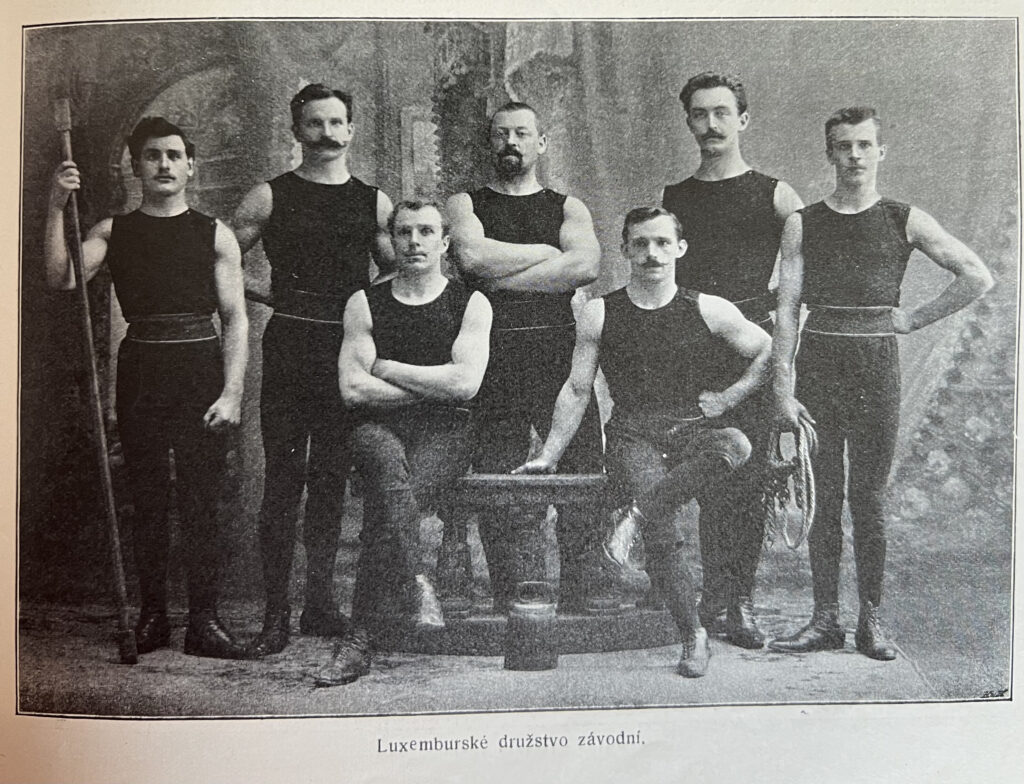
On the Hungarian Team
The Hungarians had striking outfits, but they struggled in the track and field events.
After the Belgians, the Hungarians were the most striking with their white uniforms resembling sports jerseys. They were generally slim and of medium to large build. They were weaker than all the other teams in the simple exercises, especially weight lifting, but in the simple gymnastics, they were successful in the jump and the run, although even here out of six pairs they lost five times to the Czechs, and only the famous Hungarian runner F. Kováts managed to win against competitor Erben.
Maďaři byli po Belgičanech nejnápadnější svým bílým úborem připomínající sportovní dresy. Byli vesměs štíhlých a prostředních i velkých postav. V prostných, na nářadí byli slabší všech ostatních družstev zejména tah se jim nedařil, v prostém tělocviku se jim dařil skok a běh, ač i tu ze šesti dvojic pětkrát podlehli Čechům a jen známému běhounu maďarskému F. Kovátsovi zdařilo se zvítěziti nad br. Erbenem.
On the Slovenian Team
The Slovenes were sturdy. They didn’t appear to be a cohesive team, but they deserve respect since they are a small federation.
The Slovenes also did not give the impression of uniformity. In physique and training, Dr. Murnik stood out, the others were modest trainees, of small but sturdy build and strong muscles. They lacked mainly swing and that neatness of movement where flexibility and strength merge. They were also weaker in jumping. They performed the preliminary calisthenics with strength. Their courage should be praised; despite the fact that they came from such a small association as the Slovenian Sokol community, they were not the last. How grateful we were to them for that! They have done a lot for their time.
Slovinci nečinili také dojem jednolitosti. Postavou i výcvikem vynikal dr. Murnik, ostatní byli skromní cvičenci, menších, avšak jadrných postav a silných svalů. Scházely jim hlavně švih a ona úhlednost pohybů, kde splývá pružnost se silou. Též byli slabší na skok. Prostná prováděli silou. Chváliti dlužno jejich odvahu; přes to že vyšli z tak malého sdružení, jako jest slovinská obec sokolská, nebylí posledními. Jak jsme jim byli vděční za to! Na své poměry učinili mnoho.
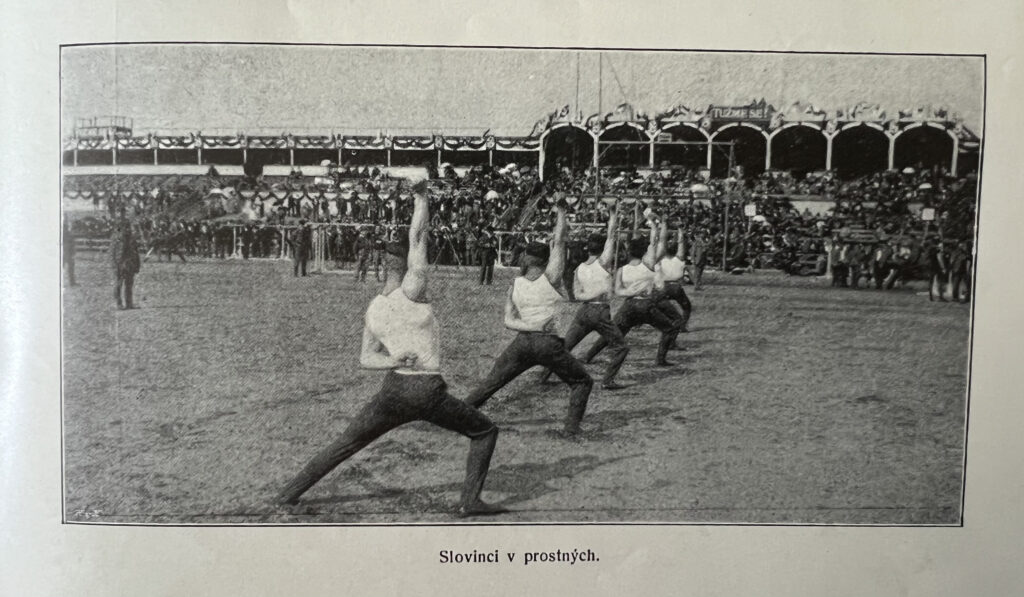
On the Czech Team
The Czechs started training together at the beginning of June. Here’s what their schedule looked like:
From the beginning of June they were summoned to Prague and prepared for their difficult task under the leadership of competitor Erben. Having retreated from the whirlwind of the meeting preparations to the backstreets of the Lesser Town gymnasium under Nebozízek, they devoted themselves entirely to rehearsals and hardening, from 7-11 a.m. and from 3-8 p.m. Evening. Their schedule was as follows: On odd days from 7:30 -8:15 jump, from 8:15-9:30 parallel bars, from 9:30-10 breakfast, then run at Letná until noon. In the afternoon from 3-3:45 long horse vault, from 3:45-5 high bar, 5-6 free time, from 6-7:30 pommel horse, then weights. On even days from 7:30 -8:15 long horse vault, 8:15-9:30 parallel bars, from 10-11 and even longer, preliminary calisthenic exercises. Afternoons from 3-3:30 jump, 3:30-5 pommel horse, 6-7 preliminary calisthenic exercises, from 7-8 alternate horse and high bar.
Od počátku června svolání byli do Prahy a připravovali se Za vedení br. Erbena k obtížnému svému úkolu. Uchýlivše se od víru sletových příprav do zátiší malostranské tělocvičny pod Nebozízkem, věnovali se cele nacvičování a otužování, od 7—11 hod. ráno a od 3—8 hod. Večer. Rozvrh měli tento: V liché dny od 7½ —8¼ , skok, od 8¼ ,—9½ bradla, od 9½—10 snídaně, pak běh na Letné až přes poledne. Odpoledne od 3—3¾ kůň na děl, od 3¾—5 hrazda, 5—6 volno, od 6—7 ½ kůň na šíř, pak břemena. V sudé dny od 7½ —8¼ kůň na dél, 8¼—9½ bradla, od 10—11 i déle prostná. Odpoledne od 3—3½ skok, 3 ½—5 kůň na šíř, 6—7 prostná, od 7—8 střídavě kůň a hrazda.
Their training helped on several events, and it prepared them to compete in the afternoon heat.
The greatest progress has been made in jumping, on the parallel bars, in running, in preliminary calisthenics, and weights. The worst was long horse vault, where the desired flexion could not be achieved. On the high bar, it was slow to make progress, as the hands suffered terribly. On the other hand, pommel horse, to which relatively the most time was devoted, while it was the weakest, showed considerable success. The competitors were hardened even against the sun, exercising outdoors all the time, which benefited them greatly at the meeting, where they competed in the greatest heat of the afternoon from 2-5 pm.
břemenech. Nejhůře šel kůň na děl, kdež žádané přednožení se nemohlo docíliti. Na hrazdě to šlo též pomalu v před, ježto trpěly strašně ruce. Za to kůň na šíř, jemuž poměrně nejvíce času se věnovalo, poněvač šel nejslaběji, vykazoval značné úspěchy. Závodníci se otužovali i proti slunci, cvičiliť stále venku, což jim na sletu, kde závodili v největším úpalu odpoledním od 2—5, velice prospělo.
While the other teams had a veritable “orgy” on the apparatus, the Czech gymnasts were more subdued and inconspicuous. Nevertheless, they garnered the respect of the audience and the judges.
The Czech team was not conspicuous either in its dress or behavior. It was as if they weren’t there. While the foreign teams, mainly the Belgians and the French, had a real orgy on the equipment before the competitions, ours sat quietly and watched. The foreign teams almost dazzled the audience with their performances, quieting the thunderous praise. Finally, in order that the audience should not get the impression that ours were no match for these, and that they were therefore keeping a low profile, they performed one exercise each on the high bar. With calmness, with confidence, giving no more and no less than it needed — you know the competitor of Erben’s school — they performed all the exercises that the foreign competitors had shown, and on top of that their own things, just as a pupil recites his task by heart. The shortness of this performance made a deep impression on all the foreign teams, their wildness abated, and the enthusiasm of the audience was aroused. Thus they secured the mood for the afternoon, where the apparatus awaited them. Our appearance was conspicuous only after you had watched them for a while. In the first place, they were generally of the same size, of medium build, of large breasts, and conspicuous for their eight-pointedness. They gave the impression of granite during the preliminary calisthenics. The sunburnt muscles tensed in every position, which they neatly and precisely marked, like ropes — postures stabbed into the ground with a hardness that was almost angular. After the French, they were the best on the preliminary calisthenics. On the apparatus, they knew what their task was, excellently. The high bar, which they were the worst at, was bested only by the French. On the parallel bars and pommel horse, they had no rivals, also in jumping, running, and weights. In jumping, competitor Starý had an accident; he, who had been assured of 20 points, had to end up with 12 points to his despair. In the run, however, though by an oversight of the judges he had to run twice, he reached 20 points, leaving his Hungarian rival far behind. — Competitor Erben, with his sprained leg causing considerable pain, scored 12 points on the jump and 16 on the run. Our men scored 20 points four times each in the weights, and that helped. Not a single one fell from the apparatus and therefore no points were lost. Their optional routines on the horse dazzled the judges […]
České drůžstvo nebylo nápadné ani úborem, ani chováním. Jak by jich tam nebylo. Kdežto cízí družstva, hlavně Belgičané a Francouzi, před závody pořádali pravé orgie na nářadí, naši klidně seděli, a pozorovali. Cizí družstva takřka oslňovala obecenstvo svými výkony klidíce bouřlivou pochvalu. Konečně, aby obecenstvo si neodnášelo dojem, že naši těmto se nevyrovnají a proto že se drží v ústrání, provedli po jednom cviku na hrazdě. S klidem, s jistotou, nedávající do pohybu nic více a nic méně než kolik potřebuje — však znáte školu br. Erbena — provedli veškeré cviky, které cizí borci ukázali a nad to své ještě věci, tak jak odříkává žák svoji úlohu nazpamět. Krátké toto vystoupení zanechalo hluboký dojem na všecka cizí družstva, divokost jejich polevila a v obecenstvu vzbudilo to nadšení. Tak si zajistili náladu pro odpoledne, kde je čekalo nářadí. Zjevem svým byli naši nápadní, až když jsi je pozoroval chvíli. Předně byli vesměs stejně velcí, prostředních postav, mohutných prsou a nápadní svojí osmáhlostí. Při prostných činili dojem žuly. Sluncem ožehnuté svaly napínaly se v každé poloze, kterou úsečně a přesně označovali, jako provazy — postoje vbodnuté do země s tvrdostí až hranatou. Po Francouzích byli na prostná nejlepší. Na nářadí uměli to co bylo jejich úlohou, výborně. Hrazda, která jim šla nejhůře, byla lepší jen u Francouzů. Na bradlech a koni na šiř neměli soupeřů, rovněž ve skocích, běhu a břemenech. Ve skoku stihla br. Starého nehoda; on, který měl 20 bodů jistých, musel k svému zoufalství skončiti na 12 bodech. Za to v běhu, ačkoli nedopatřením soudců, musel běžeti dvakrát, docílil 20 bodů, nechav svého maďarského soupeře daleko zpět. -—- Br. Erben při své podvrtnuté noze působící značné bolesti urazil na skoku přece 12 bodů a na běhu 16 bodů. V břemenech získali naši čtyřikrát po 20 bodech a to pomáhalo. Ani jediný nespadl s nářadí a neztratili tudíž žádných bodů. Volné jejich sestavy na nářadí oslňovaly soudce […]
In general, this Czech team set the example for future Czech teams.
It was an exemplary team and will always be a shining example to all those to come. The team found its greatest admirers in the rival French team, who presented the happy winners with a bouquet when the result was announced. Courtly Frenchmen!
Bylo to vzorné družstvo a bude pro vždy zářivým vzorem všem příštím. Největších obdivovatelů našlo toto družstvo u soupeřícího družstva francouzského, které při prohlášení výsledku podalo šťastným vítězům kytici. Dvorní Francouzi!
For the French, this competition was about more than gymnastics. It was a form of soft diplomacy.
Mr. Lachaud then took the floor and declared, on behalf of the Government of the French Republic, that he wished to give a vase of Sèvres as a memento of today’s competition for the winning team. He then turned to Dr. Scheiner and recalled the strange circumstance of being abandoned by all in a country whose people had once contributed their moral support to France, when France was alone in the whole world. He recalled the great importance of gymnastics in international relations and in the nation itself. And again he turned to the nation of Bohemia, which had called upon France to take up the torch of enlightenment, freedom, and civilization and to walk at the head of nations. It was the Bohemian, Belgian, and Luxembourg nation that stood by France in her worst moment, and that is why the Republic will always remain faithful to the Bohemian nation.
Slova ujal se pak p. Lachaud a prohlásil jménem vlády republiky francouzské, že odezdává vázu sěvreskou jako upomínku na dnešní závod pro družstvo vítězné. Po té obrátil se k dru Scheinerovi a o zbomh! zvláštní okolnosti, že jest v zemi, jejíž národ kdysi přispěl na pomoc Francii svou mravní podporou, když Francie byla sama jediná v celém světě, ode všech opuštěna. Vzpomenul velkého významu gymnastiky v mezinárodních stycích i v národě samém. A zase obrací se k národu českému, který volal k Francii, aby chopila pochodeň osvěty, svobody a civilisace a kcompetitionla v čele národů. Byl to národ český, belgický a luxemburský, který ve chvíli nejhorší stál po boku Francii, a proto zůstane republika českému národu povždy věrnou.
This victory solidified the Czech Sokols’ reputation both at home and abroad.
All the professional journals of Europe have written of the fitness of the Czechs, of the understanding within the nation, and today it is certain that we stand first in their eyes and that we have set the direction and pattern for gymnastics endeavors in Europe.
But even at home this victory had great moral significance. The public has always been used to seeing the Sokol as victorious, what a disappointment if it succumbed to such a strong competitor as the French or the Belgians! But it saw them victorious even over foreign countries, and it took a new confidence in its Sokol. A good fight we fought.
Všecky odborné časopisy evropské psaly o tělocvičné zdatnosti Čechů, o porozumění v národu a dnes je jisto, že v jejich očích stojíme na prvním místě a že jsme udali směr i vzor tělocvičným snahám v Evropě.
Ale i doma mělo vítězství toto veliký mravní význam. Veřejnost zvykla viděti Sokolstvo vždy jako vítězné, jaké sklamání, kdyby podlehlo třeba tak silnému sokjako byli Francouzi nebo Belgičané! Ale tak vidělo je vítězné i nad cizinou a novou důvěru pojalo k svému Sokolstu. Dobrý boj jsme bojovali.
Well, not every publication praised the Czech Sokols. The German-language press had quite a few bad things to say about the event, and that will be the subject of the next article.
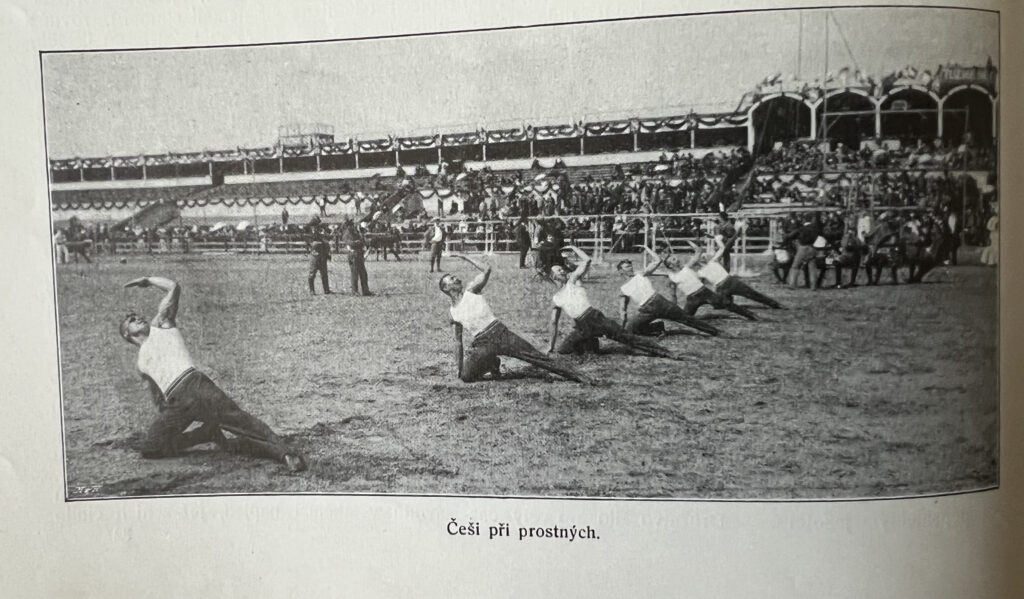
Appendix A: Every Score from the Competition
Note: You can scroll to the right in each of the tables below. An asterisk (*) indicates mathematical errors in the source text. Thanks to a diligent reader for finding those errors.
The Czech Team
| Starý | Seidl | Erben | Honzátko | Čada | Sál | Team Behavior | Total | |
| 1st Prelim | 9 | 9.75 | 9.50 | 8 | 10 | 8.75 | ||
| 2nd Prelim | 8.5 | 8.75 | 9.25 | 9.25 | 9.5 | 9 | ||
| 3rd Prelim | 9 | 9 | 9.75 | 9.50 | 9 | 9 | ||
| 4th Prelim | 9 | 8.75 | 9 | 9 | 9 | 8.25 | ||
| 5th Prelim | 9 | 10 | 9.25 | 9.25 | 10 | 9 | ||
| 44.50 | 46.25 | 46.75 | 45.00 | 47.50 | 44.00 | 1.00 | 275 | |
| Parallel Bars | ||||||||
| Approach | 1 | 1 | 1 | 1 | 1 | 1 | ||
| Comp. | 7 | 7.50 | 7 | 6.50 | 7.50 | 7 | ||
| Depart. | 0.75 | 0.75 | 0.50 | 0.50 | 0.75 | 0.75 | ||
| Approach | 1 | 1 | 1 | 1 | 1 | 0.75 | ||
| Optionals | 8 | 9 | 10 | 9 | 9.50 | 8 | ||
| Depart | 1 | 1 | 1 | 1 | 1 | 0.75 | ||
| 18.75 | 20.25 | 20.50 | 19.00 | 20.75 | 18.25 | 2.00 | 119.50 | |
| High Bar | ||||||||
| Approach | 1 | 1 | 1 | 1 | 1 | 1 | ||
| Compulsory | 9 | 6 | 9.75 | 6 | 9.25 | 8.25 | ||
| Depart | 1 | 1 | 1 | 1 | 1 | 1 | ||
| Approach | 1 | 1 | 1 | 1 | 1 | 1 | ||
| Optional | 9.75 | 8.50 | 10 | 9.25 | 9.75 | 9.50 | ||
| Depart | 1 | 1 | 1 | 1 | 1 | 1 | ||
| 22.75 | 18.50 | 23.75 | 19.25 | 23.00 | 21.75 | 2.00 | 131.00 | |
| Horse | ||||||||
| Approach | 0.75 | 1 | 0.75 | 1 | 0.75 | 1 | ||
| Comp. Vault | 8.25 | 7.50 | 9 | 7.75 | 8 | 8.50 | ||
| Depart | 1 | 1 | 1 | 1 | 0.75 | 1 | ||
| Approach | 0.75 | 1 | 0.75 | 0.75 | 1 | 1 | ||
| Opt. Pommel | 7.25 | 8 | 9.75 | 6.50 | 8.75 | 8.25 | ||
| Depart | 0.75 | 1 | 1 | 0.75 | 0.75 | 1 | ||
| 18.75 | 19.50 | 22.25 | 17.75 | 20.00 | 21.75 | 1.75 | 120.75 | |
| Athletics | ||||||||
| Jump | 12 | 14 | 12 | 20 | 20 | 14 | 92 | |
| Weights | 20 | 20 | 16 | 17 | 20 | 20 | 113 | |
| 150 m | 20 | 16 | 16 | 16 | 16 | 16 | 100 | |
| Total | 156.75 | 154.50 | 157.25 | 154.00 | 167.25 | 154.75 | 6.75 | 951.25 |
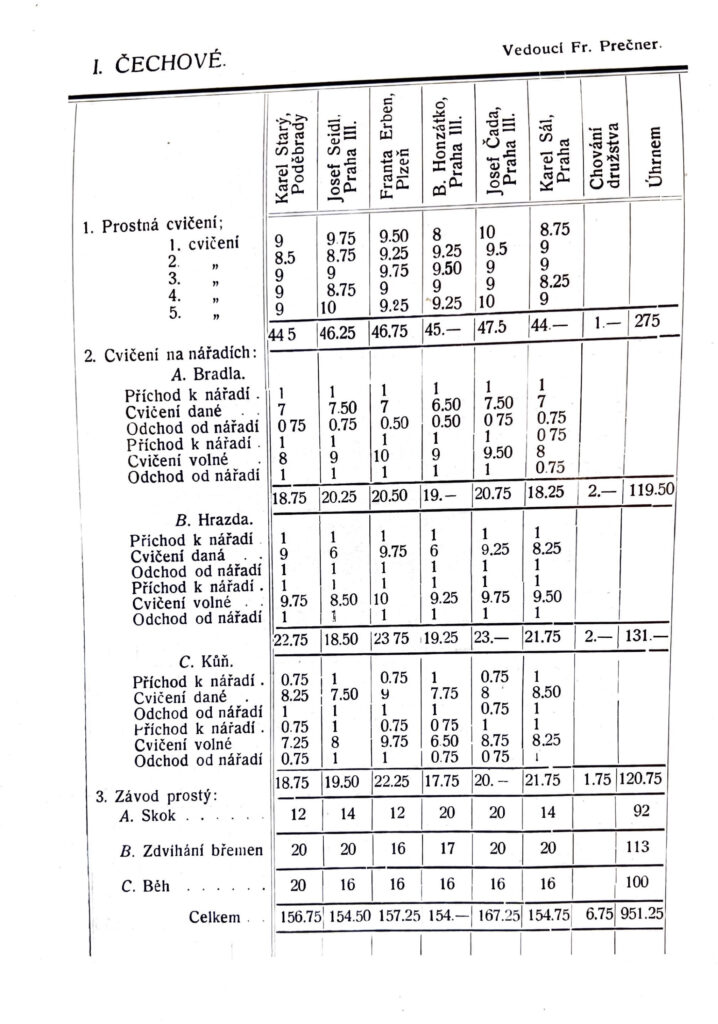
The French Team
| Charmoille | Castigliani | Vidal | Rolland | Lux | Segura | Team Behavior | Total | |
| 1st Prelim | 9 | 8.75 | 9.75 | 9.25 | 9.5 | 10 | ||
| 2nd Prelim | 9 | 9 | 9.75 | 9 | 10 | 9.75 | ||
| 3rd Prelim | 9.5 | 8.5 | 9.25 | 9.50 | 9.50 | 9.75 | ||
| 4th Prelim | 8.5 | 9 | 9.75 | 9.75 | 9 | 9.75 | ||
| 5th Prelim | 9.5 | 9.5 | 9.75 | 9.75 | 10 | 10 | ||
| 45.50 | 44.75 | 48.25 | 47.25 | 48.00 | 49.25 | 1.50 | 284.50 | |
| Parallel Bars | ||||||||
| Approach | 1 | 0.75 | 1 | 1 | 1 | 1 | ||
| Comp. | 6 | 8 | 8.5 | 7 | 8.25 | 8.75 | ||
| Depart. | 0.75 | 0.75 | 1 | 1 | 1 | 1 | ||
| Approach | 1 | 0.75 | 1 | 1 | 1 | 1 | ||
| Optionals | 9 | 8.50 | 5 | 9 | 9.50 | 8 | ||
| Depart | 0.75 | 0.50 | 1 | 1 | 1 | 0.75 | ||
| 18.50 | 19.25 | 17.50 | 20.00 | 21.75 | 20.50 | 2.00 | 119.50 | |
| High Bar | ||||||||
| Approach | 1 | 1 | 1 | 1 | 1 | 1 | ||
| Compulsory | 9.75 | 9.75 | 10 | 9.50 | 9 | 9 | ||
| Depart | 1 | 1 | 1 | 1 | 1 | 1 | ||
| Approach | 1 | 1 | 1 | 1 | 1 | 1 | ||
| Optional | 10 | 9.50 | 10 | 10 | 10 | 10 | ||
| Depart | 1 | 0 | 1 | 1 | 1 | 1 | ||
| 23.75 | 22.25 | 24.00 | 23.50 | 23.00 | 23.00 | 2 | 141.50 | |
| Horse | ||||||||
| Approach | 0.50 | 1 | 1 | 1 | 1 | 0.75 | ||
| Comp. Vault | 7.50 | 8 | 8 | 8.50 | 7.75 | 7 | ||
| Depart | 0.75 | 1 | 1 | 1 | 0.75 | 0.75 | ||
| Approach | 0.75 | 1 | 1 | 0.75 | 1 | 0.75 | ||
| Opt. Pommel | 6.50 | 8.25 | 8.25 | 8.75 | 8.25 | 9.50 | ||
| Depart | 0.75 | 1 | 1 | 1 | 1 | 0.75 | ||
| 16.75 | 20.25 | 20.25 | 21.00 | 19.75 | 19.50 | 2.00 | 119.50 | |
| Athletics | ||||||||
| Jump | 20 | 12 | 14 | 14 | 6 | 10 | 76.00 | |
| Weights | 13 | 20 | 14 | 17 | 14 | 10 | 88.00 | |
| 150 m | 14 | 16 | 18 | 16 | 14 | 16 | 94.00 | |
| Total | 151.5 | 154.5 | 156.00 | 158.75 | 146.50 | 148.25 | 7.5 | 923.00 |
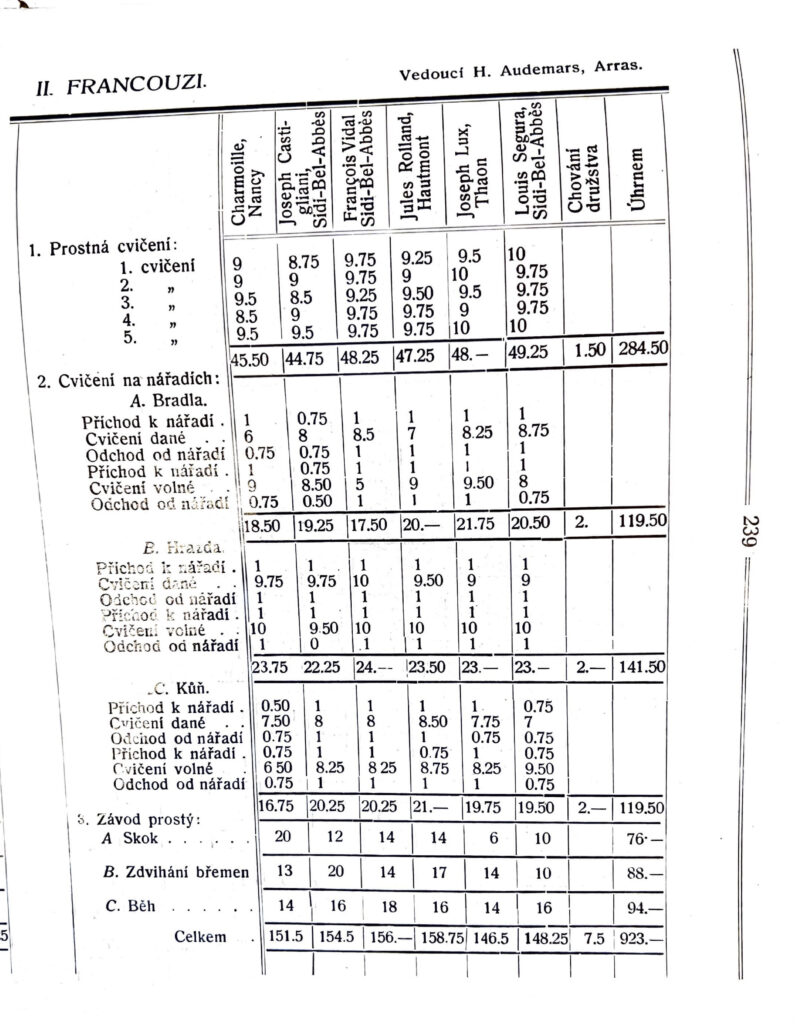
The Belgian Team
| Giesenfeld | Carsan | Lannie | Winter | Pauvels | Mangin | Team Behavior | Total | |
| 1st Prelim | 9 | 8 | 9.25 | 9.50 | 8.75 | 8.50 | ||
| 2nd Prelim | 10 | 8.75 | 9 | 9.50 | 9 | 9.25 | ||
| 3rd Prelim | 9.50 | 8.25 | 9.50 | 9.50 | 9.50 | 9 | ||
| 4th Prelim | 10 | 8.75 | 9.25 | 9.25 | 10 | 9.50 | ||
| 5th Prelim | 10 | 8.50 | 9.50 | 9.25 | 6 | 9 | ||
| 48.50 | 42.25 | 46.50 | 47 | 43.25 | 45.25 | 2 | 274.75 | |
| Parallel Bars | ||||||||
| Approach | 1 | 0.75 | 1 | 1 | 1 | 1 | ||
| Comp. | 6 | 2.50 | 5.50 | 4 | 7 | 6 | ||
| Depart. | 1 | 0.50 | 0.50 | 0.75 | 0.50 | 0.75 | ||
| Approach | 1 | 0.75 | 1 | 0.50 | 0.75 | 0.75 | ||
| Optionals | 8 | 4 | 8 | 7 | 9 | 6.50 | ||
| Depart | 1 | 0.75 | 1 | 0.50 | 0.75 | 0.75 | ||
| 18.00 | 9.25 | 17.00 | 13.75 | 19.00 | 15.75 | 2.00 | 94.75 | |
| High Bar | ||||||||
| Approach | 1 | 1 | 1 | 1 | 1 | 1 | ||
| Compulsory | 9 | 4.75 | 8 | 7.75 | 9 | 9 | ||
| Depart | 1 | 1 | 1 | 1 | 1 | 1 | ||
| Approach | 1 | 1 | 1 | 1 | 1 | 1 | ||
| Optional | 9.50 | 6 | 8 | 8.75 | 9.50 | 9.75 | ||
| Depart | 1 | 1 | 1 | 1 | 1 | 1 | ||
| 22.50 | 14.75 | 20.00 | 20.50 | 22.50 | 22.75 | 2.00 | 125.00 | |
| Horse | ||||||||
| Approach | 1 | 1 | 1 | 1 | 1 | 1 | ||
| Comp. Vault | 6.75 | 8.25 | 7.75 | 9.25 | 8.75 | 9.50 | ||
| Depart | 1 | 1 | 1 | 1 | 1 | 0.75 | ||
| Approach | 1 | 1 | 1 | 1 | 1 | 1 | ||
| Opt. Pommel | 5 | 7.50 | 6.75 | 6.50 | 7.75 | 7.75 | ||
| Depart | 1 | 1 | 1 | 0.75 | 1 | 1 | ||
| 16.50 | 19.75 | 18.50 | 19.50 | 20.50 | 21.00 | 2.00 | 117.75* | |
| Athletics | ||||||||
| Jump | 10 | 8 | 10 | 14 | 14 | 12 | 68.00 | |
| Weights | 15 | 18 | 20 | 20 | 16 | 11 | 100.00 | |
| 150 m | 14 | 14 | 16 | 18 | 16 | 14 | 92.00 | |
| Total | 144.50* | 126.00 | 148.00 | 152.75 | 151.25 | 141.75 | 8.00 | 872.25* |
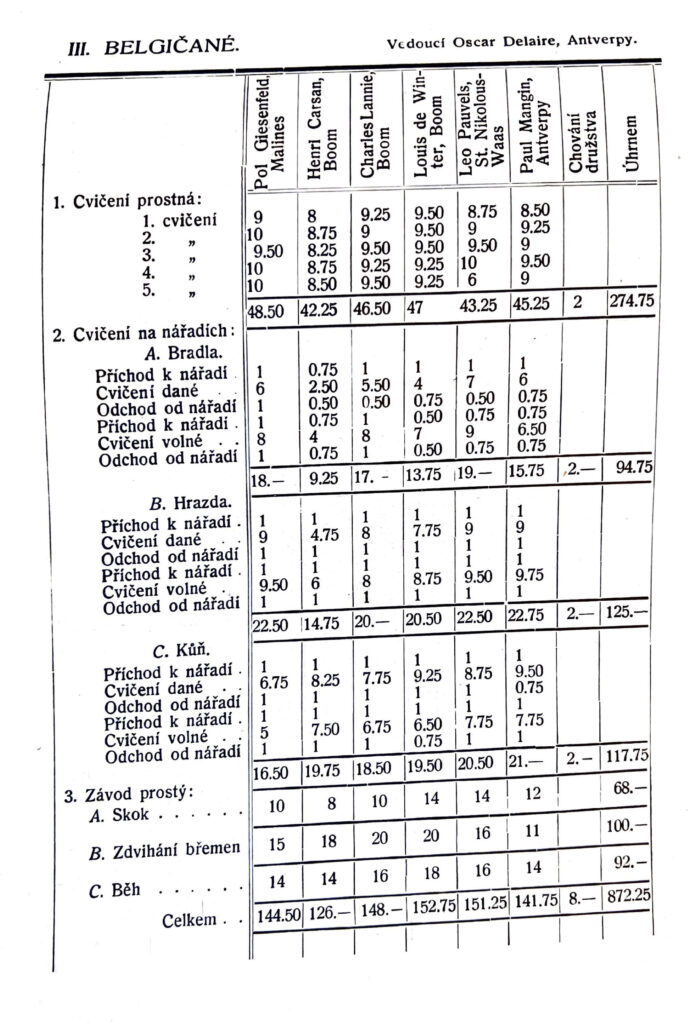
*If you add up Giesenfeld’s individual scores in the table above, his all-around total is 143.75. 0.75 is missing from his individual scores on vault. It is possible that he received a 5.75 for his optional vault.
The Luxembourgian Team
| Hary | Behm | Kanivé | Bordaug | Greiveldinger | Kummer | Team Behavior | Total | |
| 1st Prelim | 8 | 6.50 | 8.75 | 9.50 | 7.50 | 9.50 | ||
| 2nd Prelim | 8 | 7 | 7.50 | 9.50 | 8 | 8.75 | ||
| 3rd Prelim | 8 | 6.25 | 7.50 | 9.75 | 8 | 8.50 | ||
| 4th Prelim | 6 | 4 | 7.25 | 9.75 | 7 | 7 | ||
| 5th Prelim | 8 | 6.50 | 8.75 | 9.50 | 7.50 | 9.75 | ||
| 38.00 | 30.25 | 39.75 | 48.00 | 38.00 | 43.50 | 1.50 | 239.00 | |
| Parallel Bars | ||||||||
| Approach | 1 | 0.75 | 0.50 | 0.75 | 0.50 | 0.50 | ||
| Comp. | 7 | 5 | 4.50 | 6 | 3 | 2.25 | ||
| Depart. | 1 | 0.50 | 0.50 | 0.50 | 0.50 | 0.50 | ||
| Approach | 0.50 | 0.50 | 0.75 | 1 | 1 | 0.75 | ||
| Optionals | 6 | 6 | 6.50 | 7 | 7.50 | 6 | ||
| Depart | 0.50 | 0.50 | 0.50 | 0.75 | 0.75 | 0.50 | ||
| 16.00 | 13.25 | 13.25 | 16.00 | 13.25 | 15.50 | 2.00 | 84.25 | |
| High Bar | ||||||||
| Approach | 1 | 1 | 1 | 1 | 1 | 1 | ||
| Compulsory | 8.25 | 7.5 | 8.25 | 0 | 0 | 4 | ||
| Depart | 1 | 1 | 1 | 1 | 1 | 1 | ||
| Approach | 1 | 1 | 1 | 1 | 1 | 1 | ||
| Optional | 0.75 | 8 | 9 | 9.25 | 9.25 | 8 | ||
| Depart | 1 | 0 | 1 | 1 | 1 | 1 | ||
| 22.00 | 18.50 | 21.25 | 13.25 | 13.25 | 16.00 | 2.00 | 106.25 | |
| Horse | ||||||||
| Approach | 0.75 | 0.75 | 0.75 | 0.50 | 0.75 | 0.75 | ||
| Comp. Vault | 5.75 | 5.75 | 5.75 | 5.50 | 6 | 5 | ||
| Depart | 0.50 | 0.75 | 1 | 0.50 | 0.75 | 0.75 | ||
| Approach | 0.75 | 0.75 | 0.75 | 0.75 | 0.75 | 0.50 | ||
| Opt. Pommel | 4.50 | 4.75 | 4.75 | 5.25 | 4.25 | 4.75 | ||
| Depart | 0.75 | 0.50 | 1 | 0.50 | 1 | 0.50 | ||
| 13.00 | 13.25 | 14.00 | 13.00 | 13.50 | 12.25 | 1.25 | 80.25 | |
| Athletics | ||||||||
| Jump | 12 | 12 | 18 | 12 | 10 | 6 | 70 | |
| Weights | 20 | 20 | 18 | 18 | 20 | 15 | 111 | |
| 150 m | 14 | 18 | 18 | 16 | 16 | 16 | 98 | |
| Total | 135.00 | 125.25 | 142.25 | 136.25 | 124.00 | 124.25 | 6.75 | 788.75 |
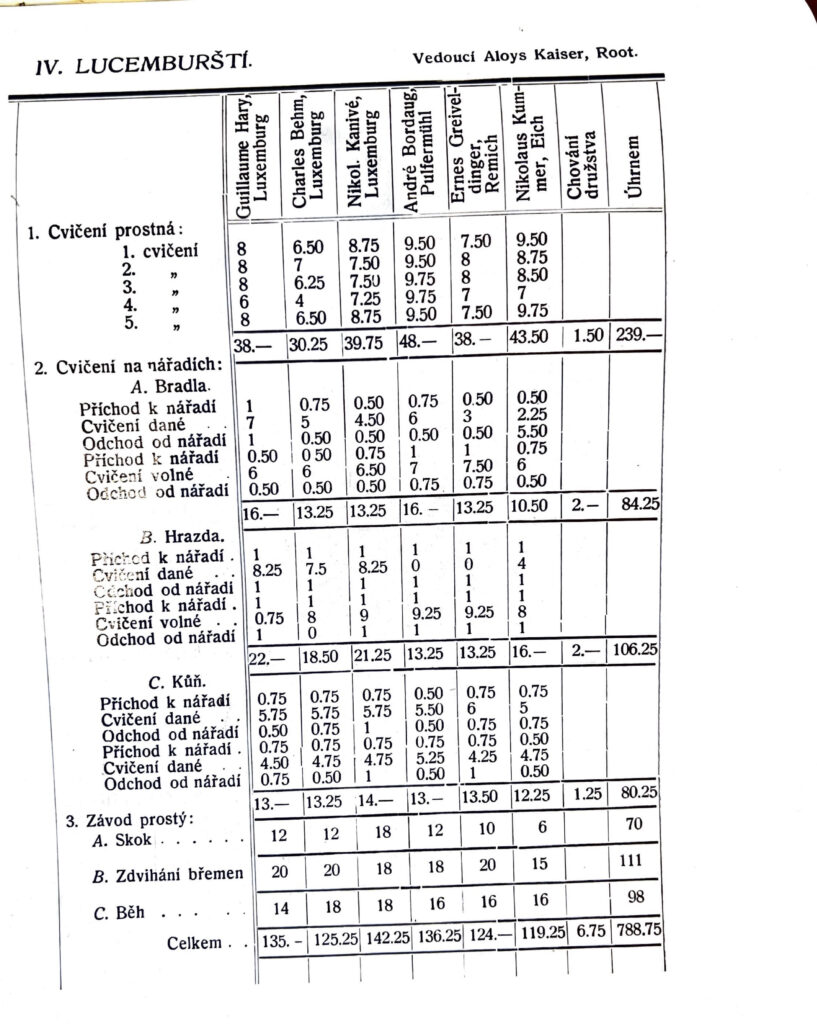
Note: Kummer’s departure from the compulsory parallel bars is listed as a 5.50 in the graphic above. However, the maximum for the dismount was 1.0. The 5.50 was likely a typo, and the correct number likely should be 0.50.
The Slovenian Team
| Murnik | Miklavk | Deklevec | Kandare | Thaler | Rihar | Team Behavior | Total | |
| 1st Prelim | 8 | 8 | 9 | 8 | 8 | 9.50 | ||
| 2nd Prelim | 8 | 7.50 | 9.25 | 9 | 8.75 | 8.75 | ||
| 3rd Prelim | 8 | 7.75 | 9 | 9.25 | 9 | 9 | ||
| 4th Prelim | 7.50 | 7.75 | 8.50 | 9 | 8.50 | 9.50 | ||
| 5th Prelim | 7 | 6.50 | 8.75 | 9.25 | 9 | 9.75 | ||
| 38.50 | 37.50 | 44.50 | 44.50 | 43.25 | 46.50 | 1.25 | 256.00 | |
| Parallel Bars | ||||||||
| Approach | 0.75 | 0.50 | 0.75 | 0.75 | 0.50 | 0.75 | ||
| Comp. | 5 | 4 | 5 | 6 | 3 | 3.50 | ||
| Depart. | 0.75 | 0.50 | 0.25 | 0.50 | 0.50 | 0.50 | ||
| Approach | 0.50 | 0.75 | 0.75 | 1 | 0.75 | 0.25 | ||
| Optionals | 7.00 | 5.50 | 4.75 | 7.50 | 5.50 | 6.00 | ||
| Depart | 0.50 | 0.50 | 0.50 | 1 | 0.75 | 0.25 | ||
| 14.50 | 11.75 | 12.00 | 16.75 | 11.00 | 11.25 | 1.00 | 78.25 | |
| High Bar | ||||||||
| Approach | 1 | 1 | 1 | 1 | 1 | 1 | ||
| Compulsory | 8.50 | 0 | 0 | 9.50 | 6 | 0 | ||
| Depart | 1 | 1 | 1 | 1 | 1 | 1 | ||
| Approach | 1 | 1 | 1 | 1 | 1 | 1 | ||
| Optional | 9.25 | 6.50 | 8 | 9.75 | 8.75 | 6 | ||
| Depart | 1 | 1 | 1 | 1 | 1 | 0 | ||
| 21.75 | 10.50 | 12.00 | 23.25 | 18.75 | 9.00 | 2.00 | 97.25 | |
| Horse | ||||||||
| Approach | 0.75 | 0.75 | 0.50 | 0.75 | 0.50 | 0.75 | ||
| Comp. Vault | 7.50 | 7.25 | 7.25 | 8.25 | 7 | 6.50 | ||
| Depart | 0.75 | 0.75 | 0.50 | 0.75 | 0.50 | 0.75 | ||
| Approach | 0.75 | 1 | 0.75 | 0.75 | 0.50 | 0.75 | ||
| Opt. Pommel | 7.25 | 8.50 | 6.75 | 7 | 6 | 7.50 | ||
| Depart | 1 | 1 | 0.50 | 0.75 | 0.75 | 0.75 | ||
| 18.00 | 19.25 | 16.25 | 18.25 | 15.25 | 17.00 | 1.75 | 105.75 | |
| Athletics | ||||||||
| Jump | 10 | 14 | 10 | 6 | 6 | 10 | 56 | |
| Weights | 20 | 15 | 11 | 20 | 19 | 15 | 100 | |
| 150 m | 12 | 14 | 14 | 16 | 12 | 10 | 78 | |
| Total | 134.75 | 122.00 | 119.75 | 144.75 | 125.25 | 118.75 | 6.00 | 771.25 |
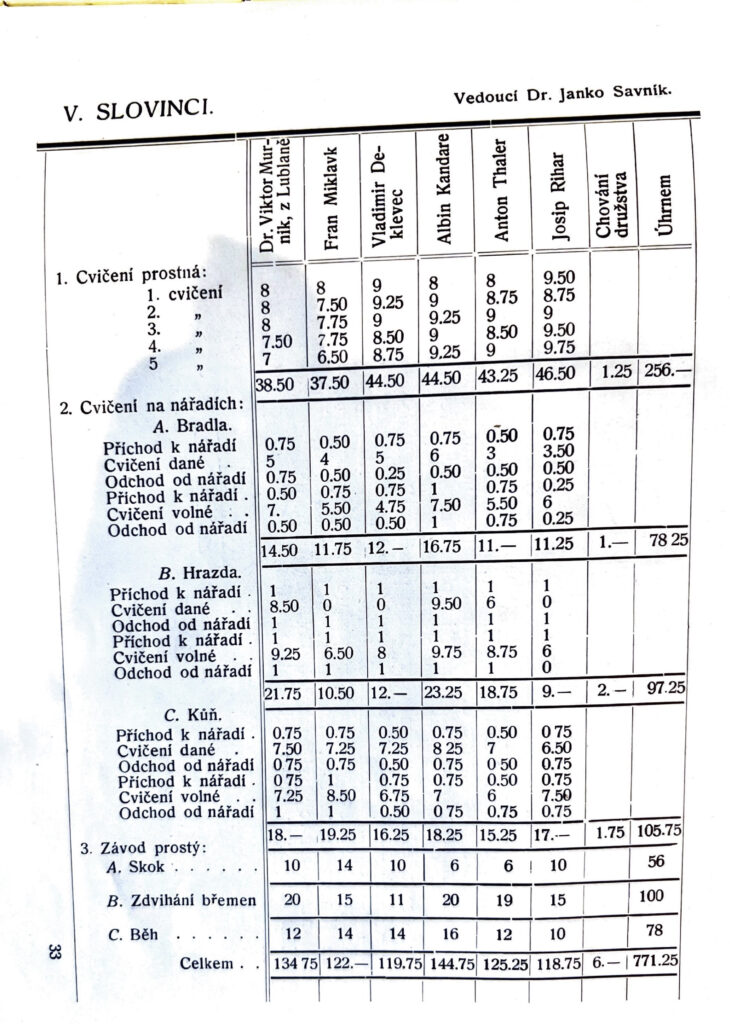
The Hungarian Team
| J. Kmetykó | Béla | L. Kmetykó | Kováts | Bak | Bajor | Team Behavior | Total | |
| 1st Prelim | 7.50 | 7.00 | 8.75 | 8.75 | 8.50 | 6.00 | ||
| 2nd Prelim | 7.50 | 6.50 | 8.75 | 9.00 | 9.75 | 7.00 | ||
| 3rd Prelim | 8 | 7.50 | 8.25 | 8.75 | 8.00 | 6.500 | ||
| 4th Prelim | 7.50 | 7 | 7.50 | 9.25 | 7.50 | 6.00 | ||
| 5th Prelim | 7.50 | 8 | 9.25 | 8.75 | 9.00 | 6.75 | ||
| 38.00 | 36.00 | 42.50 | 44.50 | 42.75 | 32.25 | 1.50 | 237.50 | |
| Parallel Bars | ||||||||
| Approach | 0.50 | 0.75 | 0.50 | 0.50 | 0.25 | 0.50 | ||
| Comp. | 4 | 7 | 2 | 3.50 | 2 | 2 | ||
| Depart. | 0.25 | 0.50 | 0.25 | 0.25 | 0.25 | 0.25 | ||
| Approach | 0.50 | 0.75 | 0.75 | 0.50 | 0.50 | 0.50 | ||
| Optionals | 6 | 9 | 6 | 8 | 3.50 | 3 | ||
| Depart | 0.50 | 0.75 | 0.50 | 0.25 | 0.50 | 0.50 | ||
| 11.75 | 18.75 | 10.00 | 13.00 | 7.00 | 6.75 | 1.00 | 68.25 | |
| High Bar | ||||||||
| Approach | 1 | 1 | 1 | 1 | 1 | 1 | ||
| Compulsory | 8 | 4.5 | 0 | 0 | 0 | 0 | ||
| Depart | 1 | 1 | 1 | 1 | 0 | 0 | ||
| Approach | 1 | 1 | 1 | 1 | 1 | 1 | ||
| Optional | 6 | 6.5 | 7 | 8.50 | 8.00 | 3.50 | ||
| Depart | 1 | 1 | 1 | 1 | 1 | 1 | ||
| 18.00 | 15.00 | 11.00 | 12.50 | 11.00 | 6.50 | 2.00 | 76.00 | |
| Horse | ||||||||
| Approach | 0.50 | 0.50 | 1 | 1 | 0.50 | 0.75 | ||
| Comp. Vault | 5 | 4.5 | 6.75 | 6 | 5.75 | 5 | ||
| Depart | 0.75 | 0.50 | 1 | 1 | 0.50 | 0.75 | ||
| Approach | 0.75 | 0.50 | 0.75 | 0.75 | 0.50 | 0.75 | ||
| Opt. Pommel | 6 | 5.75 | 4 | 6 | 5 | 3.75 | ||
| Depart | 0.75 | 0.50 | 0.75 | 0.75 | 0.50 | 0.50 | ||
| 13.75 | 12.25 | 14.25 | 10.50* | 12.75 | 11.50 | 1.50 | 81.50 | |
| Athletics | ||||||||
| Jump | 16 | 16 | 20 | 12 | 14 | 6 | 84.00 | |
| Weights | 20 | 12 | 16 | 20 | 12 | 10 | 90.00 | |
| 150 m | 14 | 18 | 18 | 16 | 14 | 16 | 96.00 | |
| Total | 131.50 | 128.00 | 131.75 | 133.50 | 113.50 | 89.00 | 6.00 | 733.25 |
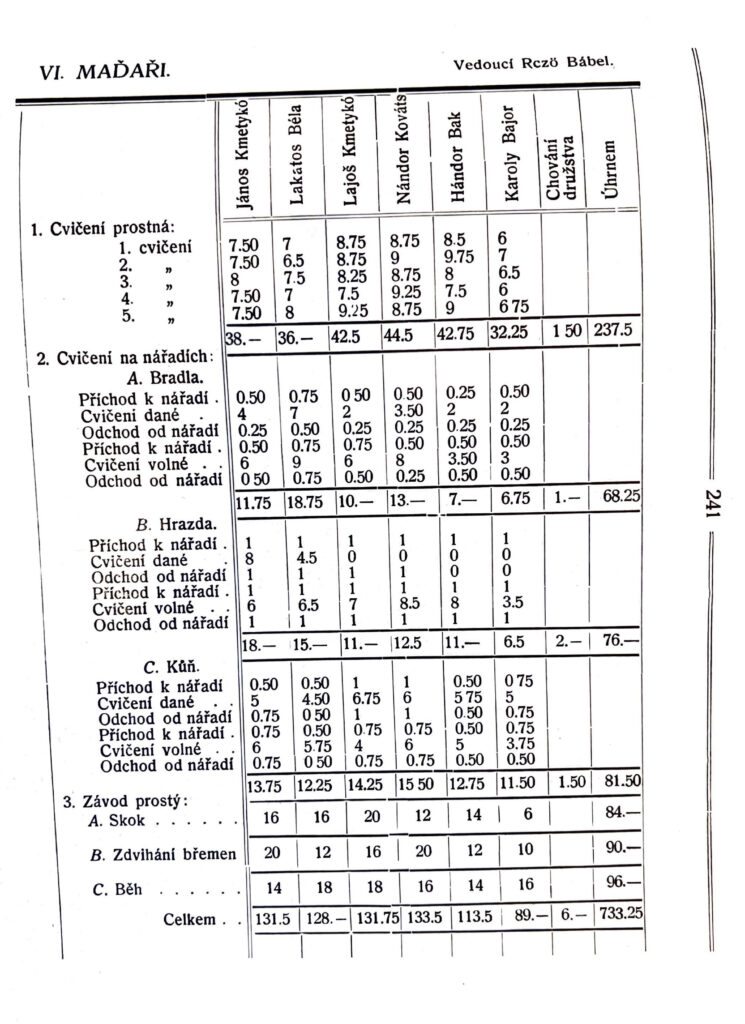
Appendix B: Footage from the Sokol Slet
You can watch video from the 1907 Sokol Rally here:
Note: Some of the footage may be from the International Tournament, but some of it clearly isn’t. For example, the footage includes rings routines, which were not part of the World Championships.
5 replies on “1907: Perfect Scores Abound at the World Championships in Prague”
I *think* that the very first person featured in the footage you supplied as Appendix B is Josef Cada, the highest AA scorer from these games. I’ve seen enough photos of him to be fairly certain of this. He did some interesting work – a static strength hold to a very bizarre contortionist-like transitional move to sit on top of the high bar. A few giants, but most spectacularly…you think all the way back then that there wouldn’t have been any actual acrobatics, but he actually dismounted with a FULL LAYOUT (good form and well-landed). (This futher bolsters my belief that it was him because he would be known for being excellent on this apparatus, seeing as he was the 2nd-highest scorer on it in 1909 and the very highest in 1911 and 1913. I can well imagine that this was the standard work for the time. I can’t wait to see what his routine looked like in 1911 and 1913, because I’m sure he upped his standards to continue to prevail.) Way to set the tone for the World Championships, Cada! He would continue to be a presence either as a competitor (which he was until after WWI, actually) or as a coach (1938 Worlds) on the competition floor for over 30 years.
I found a couple of computation errors in those original reports.
If you add up all of the scores of Giesenfeld (Belgium), they should be only 143.75, not 144.5.
Also, more obviously, Kummer of Luxembourg is shown as having a Parallel Bars total of 10.5, but really it should be a 15.5 based on the individual scores. This affects, also, his grand total which should be 5 points higher than it is, at a 124.25, not a 119.25. Very minor errors overall in a pretty sizeable data set, so no big deal, really, and they far from affect what would have been any medals at the national or individual level. Nevertheless…
I found these because I am in the process of composing this as a unified spreadsheet/table to post on the relevant Wikipedia article. First I have to do it in Excel to get the same format and to make it more sensible and easier to work with and write the code to be able to post it to Wikipedia. Then I have to actually write the code. So, it is duplicate work, essentially, but that’s the way it has to be, unfortunately, to make it come out right, especially if I also want to add rankings. In the process of composing the Excel, I decided to do composite scores, only, for the apparatuses (not the approach, routine, and dismount), and I plugged in formulas for various columns for apparatus totals and the totals of competition segments (preliminaries, gymnastics, athletics), so really it was the formulas that found the errors, “not an actual human”. LOL.
I freaking love your website!!! Reproductions of some of the original source material are a real treat and lend credibility to your website. They can also be useful for making biographical portrait photos for perhaps a gymnast or two who don’t have such a thing right now.
Thanks for your diligent data entry! I’ve updated the post to reflect the errors in the tables. As noted above, I believe that Kummer’s 10.50 is correct because there was an impossible 5.50 for one of his dismount scores. (The maximum was 1.0.) As for Giesenfeld’s all-around, it’s hard to pinpoint the error, but I’ve included my best guess above.
Silly me, I should have seen the maximum score for the dismount and automatically figured out what you said. I’m still in love with your website. There are definitely more edits to come, in addition to the few I’ve made over the last few days, from me to the relevant Wikipedia articles in the days/weeks to come.
So, I finally got the detailed results up in a unified fashion on Wikipedia. ( https://en.wikipedia.org/wiki/1907_World_Artistic_Gymnastics_Championships )
I decided not to make mention of the couple of mistakes I discovered. Since the one we discussed, with the score that was far too great to be a dismount score, once adjusted for those limits, would have made the actual score difference for that athlete just that much less and since both that and the other scoring inconsistency was so minor and was so far away from making any appreciable difference in any of the standings, I decided not to make notation of it – it just wouldn’t have been worth it.
Also, I think that the gentleman on high bar in the video is not Josef Cada. Upon looking at him further, I think I misidentified him the first time around. I think, upon second glance, it’s Frantisek Erben. The gentleman in question has too elongated a face to be Cada. It looks more like Erben, to me. Incidentally, if this had been a gymnastics-only event (just the p-bars, high bar, and vault/pommel) competition, based on the awarded scores, Karel Stary would have been the AA champion – and he had only one eye!!!